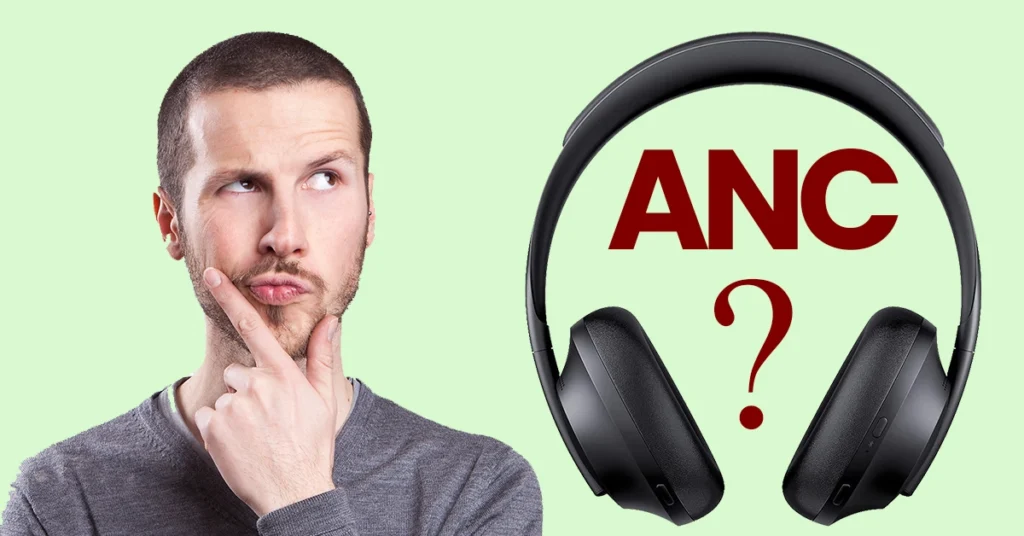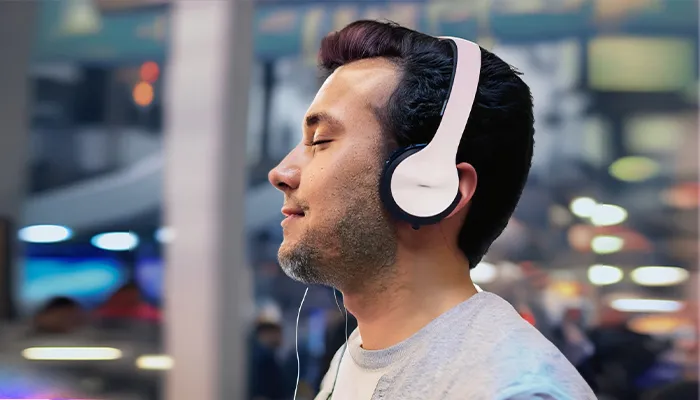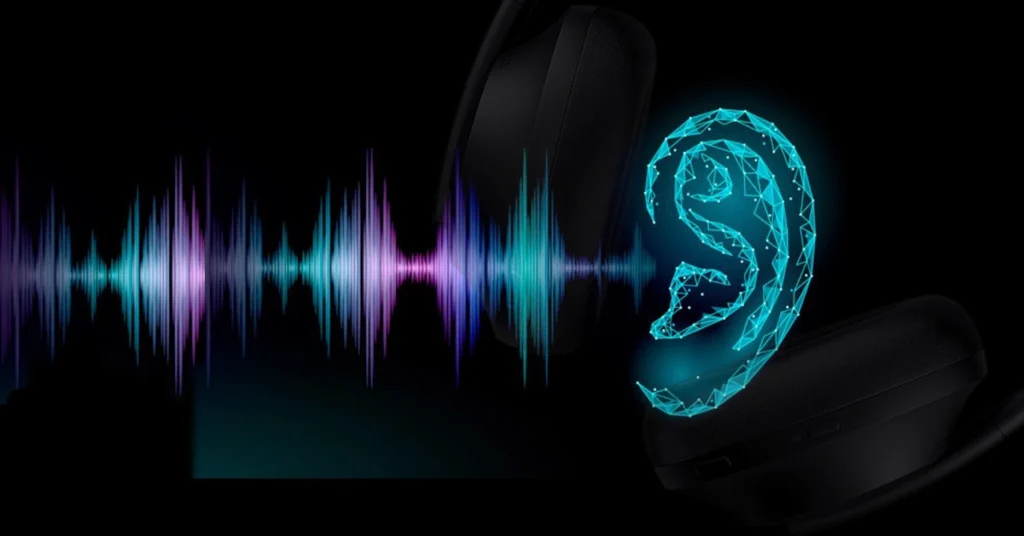Facing discomfort while using your noise-canceling headphones? You’re not alone. Many users report side effects like ear pressure, headaches, and dizziness. But don’t worry – this blog post is here to shed light on the reasons behind these issues and how to deal with them.
Join us as we dive deep into the world of active noise cancellation and its less-talked-about challenges – a must-read for any headphone user!
How Active Noise Cancellation Works
Active Noise Cancellation works by using built-in microphones to detect external sounds, then generating inverse sound waves that cancel out the unwanted noise.
Sound Vs Noise
Sound and noise might appear to be the same, but they have a significant difference. It all lies in how our brains perceive it.
The sound usually refers to something pleasant that we willingly choose to listen to, such as music or birds chirping.
On the other hand, noise is unwanted sound perceived by our ears like loud construction machinery or car honks on busy streets.
While some noises are unavoidable part of our daily routine, excessive exposure can lead to various health issues including sleep disruption and high blood pressure.
So while engaging with audio technology like headphones, we must differentiate between sound and noise for the betterment of our auditory health.
How do Headphones Cancel Outside Noise?
Headphones with active noise cancellation (ANC) technology use a pretty fascinating method to keep your audio experience free from unwanted distractions. It’s all about employing sound waves to fight off other sound waves.
The ANC headphones have built-in microphones that pick up the ambient noises in your surroundings. These microphones capture these sounds and send them to the headphone speakers.
Here comes the interesting part – Inverting these captured sounds! By creating an opposite, or inverted wave of each unwanted noise, the headphones effectively cancel them out. This process is often referred to as “destructive interference”.
When you slip on those ANC headphones, what you’re hearing isn’t just your music or podcast uninterrupted, it’s also a constant stream of anti-noise working hard to neutralize any intrusive external sounds even before they hit your ears!

Does noise canceling use microphones?
Noise-canceling technology utilizes inbuilt microphones found within the headphones. These mics play an instrumental role in identifying and analyzing ambient noise around you. Once these microphones pick up this background noise, they transmit it to the noise-canceling circuitry embedded in the device.
This advanced system then mirrors the sound waves from your surrounding environment, producing sound waves that precisely negate those unwanted noises associated with discomfort or headaches for some individuals.
Amazingly, all of this happens in real-time ensuring uninterrupted listening sessions!
Side Effects of Active Noise Cancellation
Active Noise Cancellation can have several side effects, including dizziness, headaches, nausea, ear pain, jaw pain, hearing loss, and reduced awareness of surroundings.
Dizziness
Dizziness is one of the side effects that some people may experience when using noise-canceling headphones. It can feel like a head rush or a sense of imbalance, sometimes accompanied by nausea.
While these feelings are not dangerous, they can be uncomfortable for certain individuals. Fortunately, the dizziness subsides once you stop using the headphones and does not appear to have any lasting impact.
So if you’re prone to feeling dizzy or get motion sickness easily, it’s important to be aware of this potential side effect before using noise-canceling headphones for long periods.

Headaches
Headaches can be a side effect of active noise cancellation. Some individuals may experience discomfort or even pain in their heads when using noise-canceling headphones for an extended period.
This could be due to the feeling of pressure that these headphones can create on the ears. While not everyone will experience headaches, it is important to take breaks and listen at lower volumes to minimize any potential discomfort.
Remember that headaches caused by active noise cancellation are temporary and should subside once you stop using the headphones.
Nausea
Prolonged use of noise-canceling headphones can lead to a feeling of imbalance and dizziness, sometimes accompanied by nausea. This sensation is commonly referred to as a “head rush” and can be uncomfortable for some individuals.
Although these side effects are not dangerous, they may cause discomfort while using headphones. It’s important to take breaks from wearing headphones if you experience these symptoms and listen to your body’s signals.
Ear Pain
Ear pain is another side effect that some people may experience when using noise-canceling headphones. The pressure created by the active noise cancellation technology can cause discomfort in the ears, leading to pain and sometimes even headaches.
This sensation of ear pressure can be bothersome for individuals, especially if they are sensitive to changes in air pressure or have pre-existing conditions like sinusitis. It’s important to note that these effects are temporary and usually subside once you stop using the headphones.
However, if you do experience persistent or severe ear pain while using noise-canceling headphones, it’s advisable to consult with a healthcare professional to ensure there aren’t any underlying issues causing this discomfort.

Jaw Pain
Jaw pain is another potential side effect of using active noise-cancellation headphones. The pressure applied to the ears by these headphones can sometimes lead to discomfort and pain in the jaw area.
While this side effect may not affect everyone, it is something to be aware of if you decide to use noise-canceling headphones. Remember that taking breaks from wearing them and adjusting their fit can help alleviate any discomfort you might experience.
Hearing Loss
Prolonged use of noise-canceling headphones can potentially lead to hearing loss. The constant exposure to loud music or sounds at high volumes can damage the delicate structures in our ears over time.
This damage can result in a permanent decrease in our ability to hear certain frequencies, making it harder for us to understand conversations or enjoy music. It is important to use noise-canceling headphones responsibly and take breaks from using them to prevent any long-term hearing problems.
Reduced Awareness of Surroundings
Active noise cancellation technology is designed to block out unwanted noise and create a peaceful environment for you to enjoy your music or focus on tasks. However, one of the side effects of using noise-canceling headphones is that it can reduce your awareness of your surroundings.
This means that you may not hear important sounds around you, such as someone calling your name or a car horn honking. While this may be great for blocking out background noise in certain situations, it’s essential to use caution and be mindful of the potential risks involved.
It’s important to remember that reducing our awareness of our surroundings can impact our safety and put us at risk in certain environments. So, when using active noise cancellation technology, we should always prioritize personal safety by being aware of our surroundings and taking necessary precautions.
Is noise canceling bad for your Brain?
Active noise cancellation, while providing relief from external sounds, does not have any harmful effects on the brain. There is no evidence to suggest that using noise-canceling headphones has a negative impact on our brain function or health.
The side effects associated with active noise cancellation, such as dizziness and headaches, are temporary and subside when you stop using the headphones. It’s important to note that these side effects vary from person to person, and not everyone will experience them.
So if you enjoy the benefits of active noise cancellation, go ahead and use your headphones without worrying about any adverse effects on your brain.

Effectiveness of Active Noise Cancellation
Active noise cancellation can greatly reduce external noise, creating a more immersive listening experience.
How well does it reduce noise?
Active noise cancellation technology is highly effective in reducing external noise and creating a more immersive listening experience. By using built-in microphones to detect ambient sounds, the headphones generate sound waves that cancel out these unwanted noises.
This means that background chatter, traffic noise, and other distractions are significantly reduced, allowing you to focus on your music or audio content without interruption.
Studies have shown that active noise cancellation can reduce environmental noise by up to 70 decibels, which is a significant reduction. Whether you’re on a busy commute, in a noisy office, or simply trying to relax at home, wearing noise-canceling headphones can create a peaceful environment where you can fully enjoy your audio without any disturbances.
It’s important to note that while active noise cancellation effectively reduces external sounds, it may not eliminate all types of noises. Sudden loud sounds like sirens or alarms may still be heard as they are difficult for the technology to completely counteract.
Types of ANC and their pros and cons
Active Noise Cancellation (ANC) comes in different forms, each with its advantages and disadvantages. It’s important to know these factors so you can make an informed decision on the type of ANC that suits your needs best.
| Type of ANC | Pros | Cons |
| Feedforward ANC | Great at blocking high-frequency sounds. It uses a microphone position outside the ear cup, allowing it to capture and eliminate noise before it reaches your ears. | Struggles with low-frequency noises. Also, its positioning makes it susceptible to wind noise. |
| Feedback ANC | Excellent at counteracting low-frequency noises. The microphone is located inside the ear cup, making it less affected by the wind. | Coping with high-frequency sound can be a challenge. It also runs the risk of creating a feedback loop which can lead to a high-pitched noise if the microphone picks up the sound from the speakers. |
| Hybrid ANC | Utilizes both feedforward and feedback ANC, offering the best of both worlds. It’s capable of handling a wide range of noise frequencies effectively. | More expensive due to the complexity of the technology. Some people may experience a feeling of pressure on the ears, causing discomfort or headaches. |
Each type of ANC technology has its place, and depending on your specific needs and budget, one may be more suitable for you than the others. However, it’s worth noting that prolonged use of any ANC headphones may lead to side effects such as ear pain, dizziness, or even potentially contribute to tinnitus. Therefore, it’s important to use them responsibly.

Safety Considerations of Active Noise Cancellation
Active Noise Cancellation may potentially cause tinnitus and it is crucial to utilize it responsibly.
Can it cause tinnitus?
Prolonged use of noise-canceling headphones can potentially contribute to tinnitus or worsen existing symptoms. Tinnitus is a condition characterized by a constant ringing, buzzing, or humming sound in the ears, which can be quite bothersome for those experiencing it.
While not everyone who uses noise-canceling headphones will develop tinnitus, there is a possibility that the continuous exposure to artificial sounds and the pressure on the ears caused by these headphones may have an impact.
It’s important to be mindful of this potential risk and use noise-canceling headphones responsibly to protect our hearing health.
Importance of using ANC responsibly
Using active noise cancellation (ANC) can be a great way to block out unwanted sounds and enjoy your music or podcasts in peace. However, it’s important to use ANC responsibly to avoid any potential negative effects on your health.
One key aspect of responsible usage is taking breaks from wearing noise-canceling headphones for extended periods. Giving your ears and brain a break from the constant suppression of external sounds can help prevent discomfort and potential long-term damage.
Another important consideration is setting the volume at a safe level. It might be tempting to crank up the volume when using ANC because you want to drown out as much noise as possible.
However, listening at excessively high volumes can lead to hearing loss over time. Ensuring that the volume is at a comfortable level will protect your ears while still allowing you to benefit from active noise cancellation.
Lastly, it’s essential not to rely solely on ANC when you’re in potentially hazardous situations. While ANC can significantly reduce background noise, it also reduces your awareness of what’s happening around you.
This diminished situational awareness could put you at risk during activities like crossing busy streets or when engaging with others.
Preventing hearing damage when using headphones
To prevent hearing damage when using headphones, follow these tips:
Limit your listening time
Take regular breaks to give your ears a rest and reduce the risk of overexposure to loud sounds.
Use volume control
Keep the volume at a moderate level, avoiding maximum or high volumes that can cause damage to your ears.
Choose noise-canceling headphones wisely
Opt for high-quality noise-canceling headphones that effectively block out external noise without the need for excessively loud volumes.
Be aware of background noise
Avoid turning up the volume in noisy environments as it may lead to prolonged exposure to loud sounds.
Practice the 60/60 rule
Listen at no more than 60% of the maximum volume for no longer than 60 minutes at a time.
Invest in well-fitted headphones
Ensure that your headphones fit properly and create a seal around your ears, reducing the need for higher volumes to block out noise.
Sharing devices can increase volume levels, as each person tries to compensate for background noise.
Keep an eye on volume controls
If you’re using portable music players or smartphones, ensure their volume limits are set appropriately to avoid accidental increases in sound level.
Get regular hearing check-ups
Regular hearing assessments can help detect any potential issues early on and allow for prompt treatment if necessary.
Follow the manufacturer’s guidelines
Read and adhere to the instructions provided by headphone manufacturers regarding safe usage and recommended volume levels.
Conclusion
In conclusion, while active noise cancellation can significantly reduce outside noise and improve listening experiences, it is important to be aware of the potential side effects. Users may experience dizziness, headaches, nausea, and ear or jaw pain when using noise-canceling headphones.
However, these discomforts are temporary and usually subside after removing the headphones. It is crucial to use active noise cancellation responsibly and take breaks to prevent any long-term negative impacts on our brain and hearing health.
- Charging Bluetooth Headphones During Use: Is It Possible? - January 9, 2024
- Why Over-Ear Headphones Best for Hearing Health? (7 Reasons) - December 12, 2023
- Fixing the Bose Earbuds Not Charging in Case Problem: Solutions That Work - November 24, 2023
